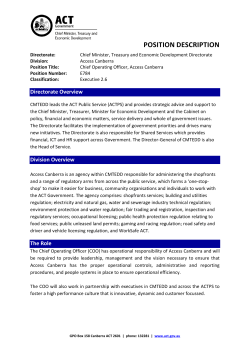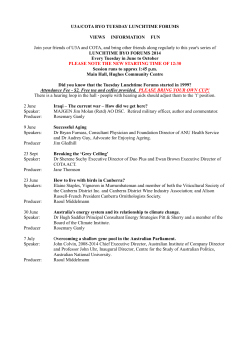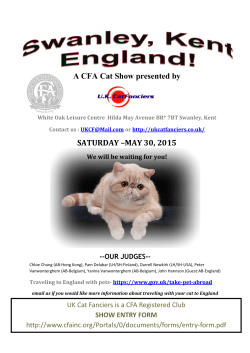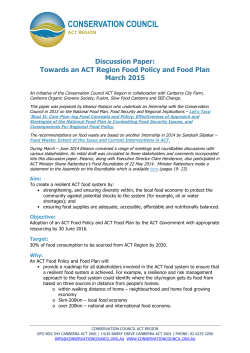
Cat containment and biodiversity protection in the ACT
31 March 2015 Shane Rattenbury MLA Minister for Territory and Municipal Services ACT Legislative Assembly GPO Box 1020 Canberra ACT 2601 Cat containment and biodiversity protection in the ACT Dear Minister The variety of life on earth – its biodiversity – has taken millions of years to develop. Its complexity is both a strength and a fragility. If something is disturbed or removed will there be a mere shimmer across the surface or will ripples build to a tsunami of losses in unexpected places? The best we know is that there are many threats to biodiversity and we have to take care, limit our losses, and take steps where we can do something to help. Of the many things we could do – one legislative instrument, one signature, would help prevent the further decline of Australia’s native species in Canberra, our Bush Capital, through addressing a key threat to our threatened species – roaming domestic cats. This would be to declare all of Canberra as cat containment with an appropriate lead in time. The ACT Domestic Animals Act 2000 provides the mechanism for targeted, practical and effective action against a key threat to threatened species in Canberra: roaming domestic cats. Canberra is well placed to be a national leader on this issue. Canberra’s nature reserves protect nationally significant remnants of Yellow Box–Red Gum Grassy Woodlands and Natural Temperate Grasslands which are amongst the most extensively cleared and fragmented vegetation types in Australia. These nationally endangered ecosystems provide habitat for over 15 threatened wildlife species and many uncommon and declining species. Of those threatened species, seven are listed as matters of national environmental significance, including the endangered Grassland Earless Dragon, Regent Honeyeater, Swift Parrot, Spotted Quoll as well as the vulnerable Superb Parrot, Striped Legless Lizard and Pink Tailed Worm Lizard. Roaming domestic cats are a common threat to our native species particularly our reptiles and woodland birds of conservation concern. This is recognized under state and national legislation. Predation by roaming domestic cats is identified as a threat for EPBC listed species. The ACT Biodiversity Action Plans such as the ACT Lowland Woodland Conservation Strategy and the Lowland Native Grassland Conservation Strategy both state: “The uncontrolled roaming of domestic cats, and in some cases dogs, in nature reserves close to urban areas is likely to contribute to increased predation on wildlife. Conservation of susceptible fauna in these areas will depend on responsible pet ownership or stronger controls”. Studies1 have shown the effect of domestic cats moving beyond suburban edges into remnant habitat is akin to the effects wrought by a predator newly introduced to an island environment. The cat is mobile, while many of the native fauna species in remnant habitats are relatively immobile 1 Tidemann C (1994) Do cats impact on wildlife, Urban Animal Management Conference Proceedings 1994, Canberra, pp. 141 – 145. Australian Veterinary Association Ltd, NSW and exist in patchily distributed and isolated fragments. Populations have been isolated and reduced largely because of habitat clearance, but domestic cat predation can be the final straw that leads to local extinctions2. This is one threatening process for which there is a simple policy solution: the implementation of stronger cat management controls. Canberra is the location of Australia’s most comprehensive study into the impacts of roaming domestic cats. This study demonstrated that domestic cats catch over 67 species of prey, and they are actively hunting during the day, when they favor ground foraging and ground-dwelling birds and reptiles. The study also showed that seasonal spikes in hunting from late spring to summer are significant for populations of small native bird species, juvenile birds and reptiles3. Separate cat tracking studies have shown that domestic cats will range as far as one kilometre into nature reserves in ACT4. The ACT has the capability to significantly reduce this decline and protect our native species with the implementation of stronger cat management and the declaration of cat containment areas in Canberra. Surveys and community education activities undertaken recently by the ACT Government and the Conservation Council has proven a high level of community support. Over two thirds of Canberra’s suburbs contain, border or are within one kilometre, a cat’s range, of important habitat for species which are vulnerable to cat predation5. The current policy that only new suburbs adjacent to nature reserves be declared as cat containment does not reflect the actual risk that domestic cats pose to our threatened native wildlife. Making a forward declaration of all of Canberra as cat containment with an appropriate lead in time will allow for residents to prepare. Such an approach would assist with a more coordinated, effective approach to threatened species conservation. Australia's Threatened Species Commissioner, Gregory Andrews is mobilising stronger action on feral cats as the key threat to Australia's mammals and has indicated his active and thorough support for this initiative as the Commissioner and as a local Canberran. There is an opportunity now for Canberra to become a national leader in biodiversity conservation management, in demonstrating how Australians can live in harmony with our native fauna through responsible pet ownership. Unlike other states and territories, the ACT has the scientific evidence, an already high level of community support and the existing legislative mechanism to significantly reduce predatory impacts of domestic animals on our native species. Yours sincerely Jon Stanhope, former Chief Minister 2 Preisser EL, Bolnick DI & Benard MF (2005) Scared to death? The effects of intimidation and consumption in predator–prey interactions, Ecology 86(2): 501–509. 3 Barratt, D (1997) Predation by house cats, Felis Catus, in Canberra, Australia, Wildlife Research, 24, CSIRO Australia 4 Barratt, D (1997) Home range size, habitat utilisation and movement patterns of suburban and farm cats Felis catus, Ecography 271 - 280 5 Eyles, K. Mulvaney, M. (2014) Responsible pet ownership and the protection of wildlife: Options for improving the management of cats in the ACT, A background paper prepared for the ACT Responsible Cat Ownership Steering Committee Signatories to letter to Minister Rattenbury, Cat containment and biodiversity protection in the ACT, 31 March 2015 1. 2. 3. 4. 5. Jon Stanhope, former ACT Chief Minister (2001-2012) Tammy Ven Dange, Chief Executive, Officer, RSPCA ACT Professor David Lindenmayer, Fenner School, Australian National University Professor John Woinarski, Charles Darwin University, Darwin John Walmsley, Prime Minister’s Environmentalist of the Year 2003, (Centenary Medal 2003) and Prudence Geddes (Centenary Medal 2003) 6. Dr Phil Gibbons, Australian National University 7. Kathy Eyles, Fenner School, Australian National University 8. Dr David Shorthouse, Visiting Fellow, Fenner School, Australian National University 9. Andreas Glanznig, Chief Executive, Invasive Animals Cooperative Research Centre 10. Hanna Jaireth, Member, IUCN World Commission on Environmental Law 11. Frank Manthey OAM, Co-Founder of Save the Bilby Fund 12. Ian Fraser, naturalist, author, awarded Australian Natural History Medallion in 2006 13. Max Bourke AM, former CEO Australian Heritage Commission, founding Director The Nature Conservancy (Australia) 14. Bob Neil, Commissioner for Sustainability and the Environment 15. Bruce Lindenmayer OAM 16. Andrew Cox, CEO, Invasive Species Council 17. Peter Ottesen, President, Conservation Council ACT Region 18. Rod Griffiths, President, National Parks Association (ACT) 19. Alison Russell-French, President, Canberra Ornithologists Group 20. Sarah Sharp, President, Friends of Grasslands 21. Kathryn Ng, President, Ginninderra Catchment Group 22. Roland Manderson, Chair, Environmental Defenders Office ACT 23. Ian Falconer, Convenor, Friends of Aranda Bushland 24. Jochen Ziel, Convenor, Friends of Mt Majura 25. Ryan Lungu, Executive Director, Canberra Environment Centre 26. Glenys Patulny, Chair, Southern ACT Catchment Group 27. Caroline Le Couteur, former ACT Greens MLA 28. Kerrie Tucker, former ACT Greens MLA 29. Dr Bob Brown, former Greens Senator for Tasmania 30. Karen Williams, President Molonglo Catchment Group 31. Waltraud Pix, Convenor, Friends of Mount Majura
© Copyright 2025










